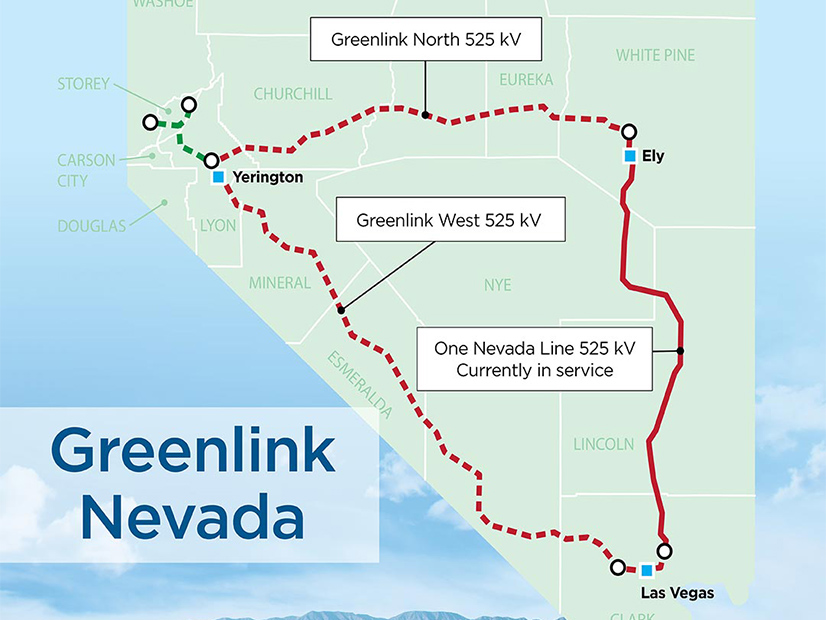
Rising costs of materials and labor and an increased use of H-frame structures as an environmental mitigation have contributed to a $1.755 billion increase in the projected cost of NV Energy’s Greenlink transmission projects.
Rising costs of materials and labor and an increased use of H-frame structures as an environmental mitigation have contributed to a $1.755 billion increase in the projected cost of NV Energy’s Greenlink transmission projects.
The costs for Greenlink North and Greenlink West, estimated at $2.484 billion in 2020, grew to $4.239 billion as of May 2024 — a 70.6% increase.
NV Energy disclosed the figures in its 2025/27 integrated resource plan, filed with the Public Utilities Commission of Nevada on May 31.
Of the $1.755 billion cost increase for the Greenlink projects, NV Energy attributed $340 million to the rising costs of materials, equipment and labor.
“Inflation has played a major role,” Shahzad Lateef, NV Energy’s senior project director for transmission development, said in the filing.
The Bureau of Land Management is requiring NV Energy to use an additional 160 miles of H-frame structures to mitigate risk to desert tortoise and sage grouse habitat, an extra cost of $124 million. Shorter span lengths and more expensive materials contribute to a 42% higher cost for H-frame structures compared to the guyed-V lattice structures that were previously planned, according to the filing.
Other environmental mitigations will add about $30 million to Greenlink costs.
Costs have also gone up $252 million because of changes in project scope, NV Energy said, and new estimates have added $101 million in sales and use taxes that previously weren’t included.
‘Vital’ to Renewables
Greenlink West will be a 525-kV line along the west side of Nevada from Las Vegas to the Fort Churchill substation near Yerington. In Northern Nevada, Greenlink North will connect the Robinson Summit substation near Ely to Fort Churchill via a 525-kV line.
The Greenlink lines, combined with the existing One Nevada line, will form a transmission triangle around the state.
“The Greenlink projects are vital to the robust development of renewable resources throughout Nevada as well as low-cost reliability for the growing load,” Ryan Atkins, NV Energy’s vice president of resource optimization and resource planning, said in the filing. “The Greenlink project remains the best alternative to meet [NV Energy’s] future transmission needs despite the cost increases.”
Breaking down the costs by project, cost estimates for Greenlink West have increased from $1.22 billion in 2020 to $1.907 billion. Greenlink North costs have gone from $854 million to $1.490 billion.
And the costs for “common ties” in the project — including a substation expansion at Fort Churchill and 345-kV connecting lines to nearby areas — have grown from $410 million to $841 million.
John Tsoukalis, a principal with The Brattle Group, also provided testimony regarding the Greenlink projects as part of NV Energy’s IRP filing.
Tsoukalis said the Greenlink projects would increase the resilience of the NV Energy system, particularly in the case of an outage of the One Nevada Line.
Greenlink also could increase interconnections with nearby entities, potentially enhancing the benefits of NV Energy’s participation in the Western Resource Adequacy Program (WRAP), Tsoukalis said.
Tsoukalis estimated the Greenlink projects would reduce costs to NV Energy customers by $50.8 million per year. Customer benefits would increase by about $57.3 million a year, as operating costs and purchased power costs declined and off-system sales revenues grew by $38 million a year, he projected.
Those gains would be offset slightly by reductions in short-term wheeling revenues, market congestion revenues and bilateral trading profits.
The next steps in the BLM permitting process for Greenlink West will be publication of the final environmental impact statement, expected this month, followed by a record of decision in August and a notice to proceed in December.
For Greenlink North, BLM is expected to release a draft environmental impact statement in July.



